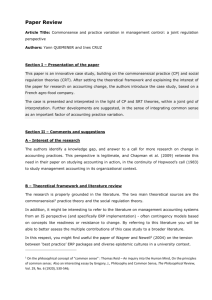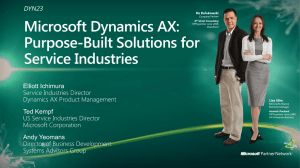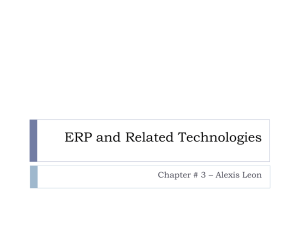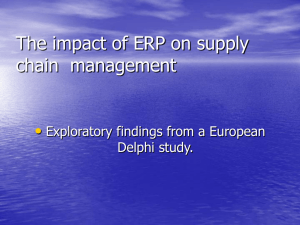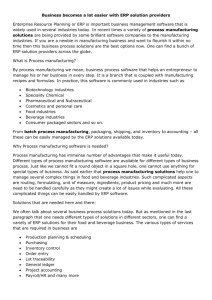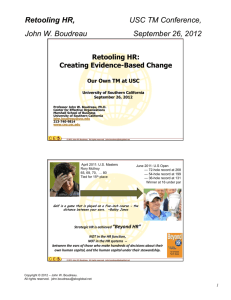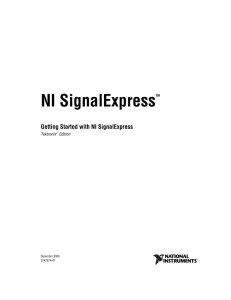Readings for April 20,2004
advertisement
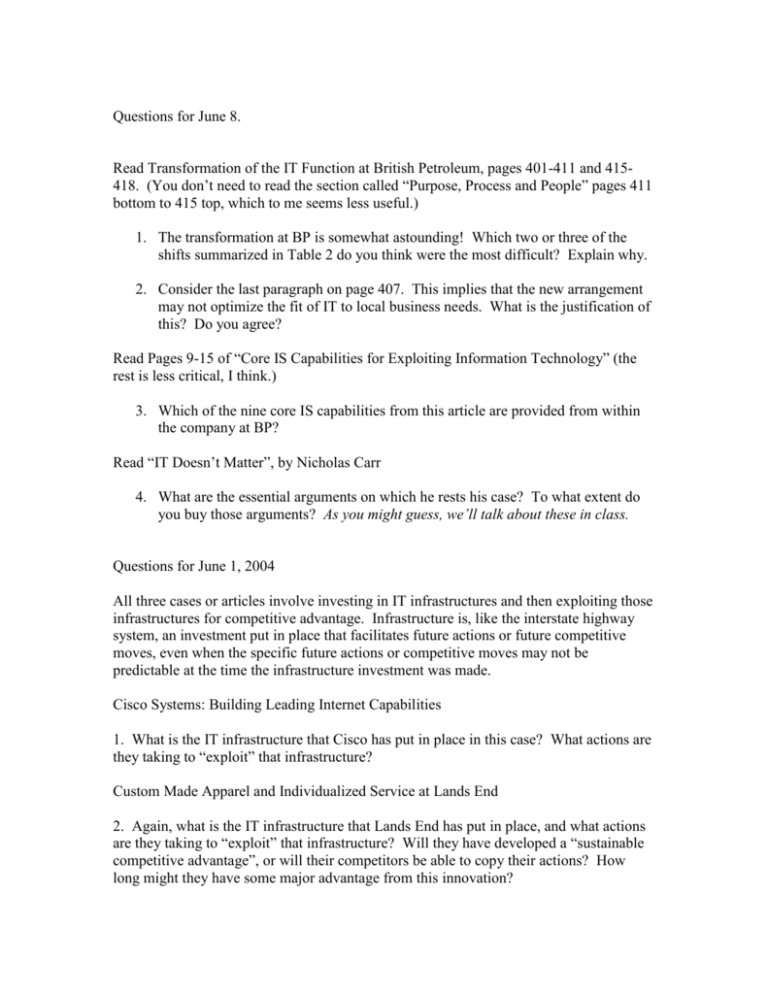
Questions for June 8. Read Transformation of the IT Function at British Petroleum, pages 401-411 and 415418. (You don’t need to read the section called “Purpose, Process and People” pages 411 bottom to 415 top, which to me seems less useful.) 1. The transformation at BP is somewhat astounding! Which two or three of the shifts summarized in Table 2 do you think were the most difficult? Explain why. 2. Consider the last paragraph on page 407. This implies that the new arrangement may not optimize the fit of IT to local business needs. What is the justification of this? Do you agree? Read Pages 9-15 of “Core IS Capabilities for Exploiting Information Technology” (the rest is less critical, I think.) 3. Which of the nine core IS capabilities from this article are provided from within the company at BP? Read “IT Doesn’t Matter”, by Nicholas Carr 4. What are the essential arguments on which he rests his case? To what extent do you buy those arguments? As you might guess, we’ll talk about these in class. Questions for June 1, 2004 All three cases or articles involve investing in IT infrastructures and then exploiting those infrastructures for competitive advantage. Infrastructure is, like the interstate highway system, an investment put in place that facilitates future actions or future competitive moves, even when the specific future actions or competitive moves may not be predictable at the time the infrastructure investment was made. Cisco Systems: Building Leading Internet Capabilities 1. What is the IT infrastructure that Cisco has put in place in this case? What actions are they taking to “exploit” that infrastructure? Custom Made Apparel and Individualized Service at Lands End 2. Again, what is the IT infrastructure that Lands End has put in place, and what actions are they taking to “exploit” that infrastructure? Will they have developed a “sustainable competitive advantage”, or will their competitors be able to copy their actions? How long might they have some major advantage from this innovation? Building IT infrastructure for Strategic Advantage 3. It is interesting and useful to think of IT infrastructure as “services” or underlying capabilities that a firm has put into place. Weill and his co-authors identify 10 different types of IT infrastructure services that an organization might invest in, and point out that services can be implemented at the business unit level, or the enterprise level. They also make the interesting point that it is very expensive to develop these services, and organizations probably have to make explicit decisions about where to invest, and at what level (enterprise or business unit). Given SRS’s strategic directions, what types of IT infrastructure investments make the best sense now, and why? (Assume a continuing, even if reduced, role for SRS into the future.) [I recognize this is a pretty challenging question!] Assignment for May 24, 2004 Write 1 and a half to two pages, single spaced on the below questions. Read: Tektronix, Inc.: Global ERP Implementation NIBCO’s Big Bang Boudreau and Robey, “Enabling Organizational Transformation…..” NOTE: Skip the “method” section of Boudreau and Robey’s paper (midway down page 4 through midway through page 8), as it is more detail than you want to know about the research method employed. 1. What technical or strategic factors motivated Tektronix to want to implement the Oracle ERP? How good a fit is such a system to their strategic needs? 2. What does "Frankfort is Orlando" mean at Tektronix? To what extent is it reasonable to standardize across all regions? How successful was this aspect of the implementation. 3. Why did NIBCO attempt a “Big Bang” implementation for its ERP? What did they do to increase their chances of success at this approach? 4. Compare and Contrast the NIBCO implementation approach with the Compass implementation approach (from Boudreau and Robey’s paper). What does each one do well? Why did the implementers of Compass do it that way? Questions for May 18 Cisco Systems, Inc.: Implementing ERP Understanding the Local Level Costs and Benefits of ERP (Cases Only) Putting the Enterprise Into the Enterprise System Prepare a one and a half to two page (total for all questions), single spaced response to the following questions based on the readings. Apportion your effort and space so you can answer all three questions. 1. Although ERP implementations are notoriously difficult, Cisco seems to have been quite successful (after a few brief hiccups). What key things did they do that contributed to their success? 2. What kinds of problems are Forest Products and Auto Products having with their ERP implementations? How important are these problems? What is causing Forest Products and Auto Products to have such a difficult time with ERP? Did they just implement it poorly, or is there some more fundamental problem? 3. Apply the ideas on strategic and cultural fit put forward by Davenport to the Cisco case, and to the two companies discussed in “Understanding the Local Level Costs and Benefits". Questions for May 11 Burlington Northern 1. What is meant by the term “strategic repositioning” in the Burlington Northern case? What is the new “vision”? What is the role of IT in that vision? 2. How compelling are the arguments for this repositioning? What are the biggest hurdles to achieving the new vision? Administrative Data Project 3. Consider the description of Redesigning the Procurement and Hiring Processes (pages 8-10). How effective would such a process be at deriving a new, more efficient process? What would explain the differences between that more efficient process and the existing process? In other words, assuming the new process really is quite different from the old process, where did the design for the old process come from? 4. What is your prediction for the future of the ADP project? Why? 5. What would you do if you were the new vice president for finance? Questions Due Tuesday April 27. National Mutual IRS Johnson & Johnson Please write a total (for all three questions) of 1 and half to 2 pages – single spaced 12 point font – on the below questions. 1. What is your assessment of the future of the Profiling system at National Mutual? What factors are important in coming to your assessment? 2. On the last page, three options are listed for future action of the ACS system. Without necessarily limiting yourself to those options, or combinations of them, what approach do you think should be taken relative to ACS? 3. J& J is considering standardizing and consolidating networking across the whole U.S region, and also standardizing at least some data definitions (things like product codes, sales etc.). What are the major benefits and difficulties in doing each of these. Is there any reason to think that standardizing data definitions will be tougher than standardizing and consolidating network operations? Questions for April 20,2004 First American 1. First American has apparently succeeded in making major changes in its organization. Enumerate some of the major things that have changed, with a brief explanation of each. What do you think were the toughest challenges for them to meet as they made these changes. 2. What was the role of top management as these changes were made? Taco Bell 3. What has changed at Taco Bell by the end of the case. Enumerate some of the major things that have changed. What was the role of information systems in these changes? Kotter, “Why Transformation Efforts Fail” 1. For First American, pick three of Kotter’s Eight Steps (each is really a way to fail) that are particularly relevant and explain how First American did or did not address the issue. Then, with perhaps a different set of three of Kotter’s steps, do the same for Taco Bell.




